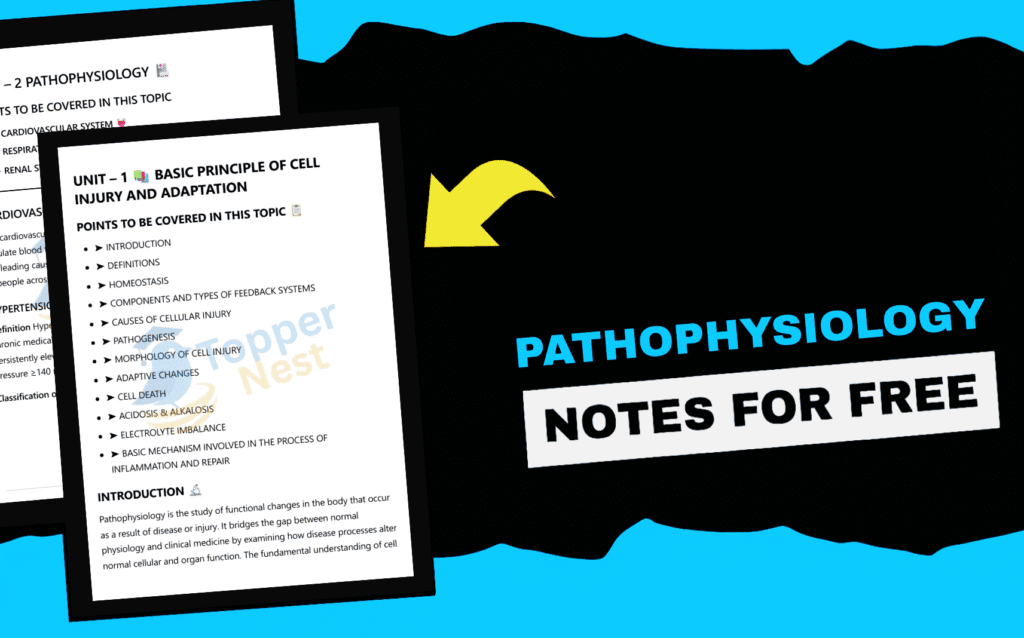Starting your professional course journey? One of the most essential subjects you’ll encounter in your first year is Pathophysiology. This subject builds your foundation in understanding the mechanisms of disease, focusing on the causes, progression, and effects of various disorders, which are vital for interpreting drug action, clinical conditions, and treatment strategies in pharmaceutical and health sciences.
Our Pathophysiology Notes are carefully prepared to make your study experience simple, well-structured, and exam-focused. Whether you need clear explanations of the basics of inflammation, cellular injury, immune responses, cardiovascular disorders, respiratory diseases, gastrointestinal disturbances, or endocrine imbalances, these notes are designed to help you grasp the concepts thoroughly and retain them effectively.
These notes will not only support your classroom learning but also serve as a quick reference guide before exams. With detailed flowcharts, step-by-step explanations, important definitions, and practice questions, Pathophysiology Notes make your preparation easier, more efficient, and exam-ready.

What is Pathophysiology?
Pathophysiology is the study of the functional and biochemical changes that occur in the body as a result of a disease, injury, or abnormal condition. It explains how normal bodily processes are disrupted and how those disruptions lead to the signs and symptoms of a disease.
Think of it as the “how” and “why” of a disease, connecting the cause of an illness to its observable effects on the body.
Pathophysiology vs. Pathology
While often confused, pathophysiology is distinct from pathology:
- Pathology is the study of the structural changes that a disease causes in cells, tissues, and organs. For example, a pathologist might examine a tissue sample under a microscope to identify a tumor or signs of inflammation. It answers the question, “What is physically wrong with the tissue?”
- Pathophysiology explains the functional mechanisms behind those changes. It answers, “How did the tumor grow and disrupt the organ’s function?” or “What biochemical processes led to the inflammation and fever?”
Core Concepts of Pathophysiology
Pathophysiology explores a disease by examining three key components:
- Etiology: This is the study of the cause of a disease. It can be a single factor (e.g., a virus) or a combination of factors (e.g., a genetic predisposition combined with an environmental trigger).
- Pathogenesis: This describes the mechanism by which a disease develops and progresses. It is the sequence of events from the initial stimulus to the ultimate manifestation of the disease. For example, the pathogenesis of a heart attack involves plaque buildup, plaque rupture, and the formation of a blood clot.
- Clinical Manifestations: These are the signs and symptoms of a disease. Signs are objective and can be measured or observed by a clinician (e.g., fever, rash, high blood pressure), while symptoms are subjective and experienced by the patient (e.g., pain, nausea, fatigue).
Importance in Healthcare
Understanding pathophysiology is essential for all healthcare professionals because it provides the foundation for diagnosis and treatment.
- Diagnosis: It allows clinicians to connect a patient’s symptoms to the underlying disease process, leading to an accurate diagnosis.
- Treatment: It guides the selection of the most effective therapies. For example, knowing the pathophysiology of diabetes (a problem with insulin) leads to treatments like insulin therapy or drugs that improve the body’s use of insulin.
- Prevention: By understanding the mechanisms of a disease, healthcare professionals can advise on lifestyle changes or other preventative measures to reduce risk.
Unit-wise Notes for Pathophysiology
Why Pathophysiology is Important in B. Pharmacy
Pathophysiology is a foundational and critical subject in a B. Pharmacy curriculum because it provides the scientific basis for understanding diseases and their impact on the body. A pharmacist cannot effectively manage drug therapy without first understanding the biological and physiological changes that necessitate that therapy.
Key Reasons for its Importance
1. Understanding Drug Action
Pathophysiology explains the “why” behind drug therapy. It details the mechanisms of disease, such as how a mutated gene leads to a faulty protein, how inflammation damages tissue, or how high blood pressure strains the heart. This knowledge is essential for a pharmacist to understand:
- Rational Drug Design: Why a specific drug targets a particular enzyme or receptor.
- Therapeutic Efficacy: How a drug restores normal function or corrects a pathological process.
- Drug-Disease Interactions: How a patient’s condition might affect a drug’s absorption, distribution, metabolism, and excretion.
2. Clinical Decision-Making and Patient Care
A pharmacist’s role extends beyond simply dispensing medication. Pathophysiology empowers them to make informed clinical decisions.
- Interpreting Symptoms: It helps a pharmacist connect a patient’s symptoms (e.g., shortness of breath) to an underlying pathological process (e.g., fluid accumulation in the lungs due to heart failure), allowing them to ask relevant questions and recommend appropriate care.
- Medication Counseling: It allows for effective patient education. A pharmacist can explain to a patient with diabetes not just what their medication does, but why they need it to control blood sugar and prevent long-term organ damage.
- Adverse Drug Reactions: Understanding the body’s normal and abnormal functions helps a pharmacist anticipate and recognize potential side effects that may arise from a drug’s interaction with a diseased system.
3. Disease Management
For many chronic diseases, a pharmacist is a key member of the healthcare team. A deep understanding of pathophysiology allows them to:
- Monitor Therapy: Evaluate whether a treatment plan is working by interpreting laboratory results and patient feedback.
- Propose Adjustments: Recommend changes to therapy based on the patient’s response and the progression of their disease.
- Collaborate with Clinicians: Communicate effectively with doctors and other healthcare professionals using a shared understanding of disease mechanisms.
